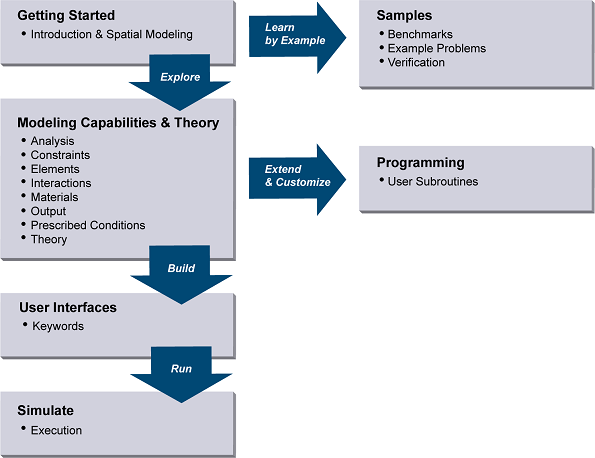Abaqus | ||
| ||
The figure below shows how you can navigate through the family of Abaqus user guides to find the information you need. 
Getting Started
If you want more details about the conventions used in Abaqus and basic finite element modeling concepts (such as defining nodes, elements, and surfaces), you should read the Introduction & Spatial Modeling guide.
Modeling Capabilities & Theory
When you have gained a basic understanding of setting up an Abaqus analysis, you can explore the numerous capabilities that make Abaqus such a powerful simulation tool. This family of guides provides a reference to the individual components of an Abaqus analysis—the Analysis types and techniques, Constraints, Elements, Interactions, Materials, Output variables and formats, and Prescribed Conditions.
For an in-depth description of the engineering principles and mathematical theories that form the foundation of Abaqus, refer to the Theory guide.
User Interfaces
The Keywords guide describes the details of the text-based interface to Abaqus.
Simulate
Once you have built your Abaqus model, the Execution guide describes how to run your analysis. For example, the guide describes command-line options, environment file settings, and options for executing your analysis using parallel, distributed systems.
Samples
The best way to become familiar with setting up an Abaqus simulation is to learn by example using the numerous samples that Abaqus provides with each release. The samples in the Benchmarks guide demonstrate that the results from Abaqus compare well with either analytical solutions or with solutions from a third-party, such as NAFEMS.
The Example Problems guide illustrates how you can use Abaqus to run simulations involving nontrivial physics. Many of these samples are complex and demonstrate how you can apply a combination of Abaqus capabilities to solve your problem.
The samples in the Verification guide do not address real-world problems; however, they provide evidence that the implementation of the Abaqus numerical model produces the expected results.
The quality of each Abaqus release is tested by running all of the simulations in the three sample guides and comparing the results with a set of known standards.
Programming
More advanced users might want to learn to extend and customize the Abaqus software. The User Subroutines guide describes how you can customize the functionality of Abaqus for particular applications; for example, you can write a user subroutine to define your own loading definition, output variable, material model, or element type.